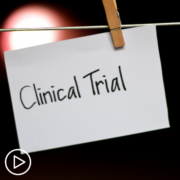Clinical Trials As an MPN Treatment Option: What You Should Know from Patient Empowerment Network on Vimeo.
Should you consider an MPN clinical trial? Dr. Ruben Mesa provides an overview of clinical trials—including the phases—and defines common trial terms and types. Dr. Mesa shares advice on trial participation and gives an update on the latest advances in MPN research.
Dr. Ruben Mesa is an international expert in the research and care of patients with myeloproliferative neoplasms (MPNs). He serves as executive director of UT Health San Antonio MD Anderson Cancer Center in San Antonio, Texas. More about this expert, here.
Download Guide
See More From MPN Clinical Trials 201
Related Programs:
Transcript:
Katherine:
Hello and welcome. I’m Katherine Banwell, your host for today’s program. Today, we’re going to discuss research advances in myeloproliferative neoplasms, or MPNs, and review key information that patients should know about clinical trial participation.
Before we get into the discussion, please remember that this program is not a substitute for seeking medical advice. Please refer to your healthcare team about what might be best for you. Well, let’s meet our guest today. Joining me is Dr. Ruben Mesa. Dr. Mesa, welcome. Would you please introduce yourself?
Dr. Mesa:
Thank you so much. It’s a pleasure to be here. I’m Ruben Mesa. I’m the executive director of the Mays Cancer Center at UT Health San Antonio MD Anderson.
Katherine:
Great. Thank you so much for joining us today. As we move through this conversation, we’ll talk about the classic myeloproliferative neoplasms, essential thrombocythemia, polycythemia vera, and myelofibrosis. So, before we dive deeper into our clinical trial discussion, let’s talk about research advances. What are the latest developments in the field of myeloproliferative neoplasms?
Dr. Mesa:
There are many advances that are very important for patients to know about. First, we’re learning more about the biology of these diseases. Why do they occur? Why do they progress? Why are they different in different individuals? Indeed, the course of these diseases can be quite variable. So, these important pieces of biology are important for us to be able to better diagnose the disease, monitor the disease, and develop better therapies.
Second, I would say that there are many important new therapies that are in development. They are only able to be developed into therapies that patients can use by the process of undergoing through clinical trials. But these therapies are for patients with essential thrombocythemia, polycythemia vera, and myelofibrosis. So, a critical part, but many different scientific advances that are important and hopefully will have an important impact for patients with MPNs.
Katherine:
Mm-hmm. It sounds very promising. And, of course, these research advances wouldn’t be possible without patients actually participating in clinical trials. So, can you help us understand more about the trials? What is a clinical trial? Let’s start with that.
Dr. Mesa:
It’s a very good question. A clinical trial is a very structured way for us to be able to ask a question, whether that question is, is a new therapy safe?
Is it effective for a particular disease? Sometimes there are clinical trials that don’t involve treatments, that involve questionnaires, or other interventions, things like exercise or yoga or other things. But in general, it’s where we are having a patient do something in a structured way that we are able to then assess. Is it safe and is it effective? Is it reaching our goal in terms of trying to have an impact on that disease, whatever that is?
So, if it’s a blood pressure medicine, it’s probably about lowering the blood pressure. If it was about the COVID vaccines, did the vaccines help people from developing COVID or make COVID less severe? So, what they’re testing is variable. But the concept is the same.
It’s a very organized way for patients to be able to receive something that is closely monitored, that has been approved in advance as being a reasonable, safe, and ethical to ask patients to participate.
Katherine:
What are the phases of clinical trials?
Dr. Mesa:
So, the phases are particularly to treatment or drug use trials for developing new therapies. And they start with Phase I, which is typically the first time a drug is tested in human beings. It’s already gone testing in the lab to see whether it should work. It likely has had some animal testing to get a sense of dose and safety. But then, the first individuals who receive the drug, it’s on Phase I. What we’re really trying to understand the safety of the drug and to try to get around the dose.
There is the Phase II, typically where we’re testing a therapy in a group of people that are all similar to see what is the effectiveness of the treatment.
So, that first phase is, is the drug safe? What is the dose? The second phase is, is the drug effective? and however we define effective for that particular disease. And then, the third phase is where that new treatment is compared against how we otherwise normally would have treated the disease. So, if that’s in the setting of where we already have a drug that is approved, it’ll be compared against that drug.
If there’s never been a drug, then that comparator could possibly be a placebo, or an inactive part, or observation, or sometimes best alternative therapy the doctors can use.
There is, finally, a fourth phase. There are times that, after a drug is approved, the FDA will ask for additional information – safety information, effectiveness information – even after approval, and that’s something referred to as the fourth phase.
Katherine:
Let’s move on to some common language used around clinical trials. I’ll mention a few and then maybe you could define them for the audience. The first one is, informed consent. What does that mean?
Dr. Mesa:
Informed consent is that what is involved with participating with a trial, what the drug is, what do we know about its safety, what you might anticipate, either in terms of side effects, whether a likely side effect or a rare side effect.
And what’s involved with you in terms of a participation, whom to call if there’s an issue. It really is an extensive document. It looks like a contract, but actually it is not.
So, informed consent is not an obligation to participate in the trial, nor does it mean that you have to stay on the trial for any length of time.
It is truly to inform you, and then you sign it, saying that you have been informed. One important concept: in the clinical trial, you are always in the driver’s seat, so that if you take – you sign the consent and you choose not to participate, you’re done then and there. If you take one dose and you don’t want to take anymore – fine. So, you’re always in the driver’s seat. It looks like a contract; it clearly is not. It is not an obligation from your side.
Katherine:
That’s good to know. What about standard of care?
Dr. Mesa:
So, standard of care is the medical language we use to how we would treat you otherwise. So, a clinical trial, by definition, is we’re trying something new.
Sometimes it’s a drug that’s never been approved, but sometimes it’s a drug that’s approved that we’re testing in a different way. Standard of care is kind of the default care that you would normally receive anyway, that is kind of the medical standard for your particular condition.
Katherine:
What does adverse event mean?
Dr. Mesa:
An adverse event means any possible side effect or event, a hospitalization or something of that nature. And then, the doctor typically attributes whether it’s related or unrelated. So, let me use an example.
If you’re on a clinical trial with a drug, but you go skiing; you fall and you break your ankle. That is an adverse event. You were hospitalized and had a broken ankle during the conduct of the study.
Now, it likely is not attributed to the trial drug, and that’ll be discussed and investigated.
But maybe it was. Maybe you felt light-headed and you passed out because of the drug you were on and you were skiing. So, again, that is a determination that your doctor makes about an adverse event. But it’s an adverse event whether it’s related to the drug or whether it has nothing to do with the drug.
Katherine:
And what about HIPAA? What does that mean?
Dr. Mesa:
HIPAA relates to – and I forget the full acronym – but really, it’s around the integrity of your patient information and that that is not able to be disclosed in a way that is either harmful to you or to individuals that really are not authorized to receive that information, which typically includes your treating team with permission – if you give permission to another healthcare provider or system, to your insurance company, et cetera.
But it’s really around both portability, I believe, in terms of your patient record, but also in terms of privacy.
Katherine:
A big concern for patients who may be considering participating in a clinical trial is fear that they will receive a placebo. Can you define what a placebo is for the audience?
Dr. Mesa:
So, a placebo means a drug that is inert. So, historically, a placebo has been, let’s say, like a sugar pill.
So, one, it is a very small minority of trials in this day and age that have a placebo. So, one, it’s almost solely in the setting of a Phase III trial. So, in a Phase I trial, everyone gets the drug. In a Phase II trial, typically everyone gets the drug. In a Phase III trial, there is typically something that it is compared against.
Now, if there’s a standard of care approach, that’s likely the comparison group.
Now, the group that starts with standard of care may well then have a period where they “crossover,” where they are treated in one way for a certain amount of time, and then get kind of the drug in question. A placebo is truly meant to be the same as kind of getting nothing. Now, in a disease like MPN, the number of placebo control trials is really very few. Sometimes a situation that they are used is where the comparator is, let’s say, trying to use two drugs – so, let’s say, the standard of care plus a new drug – versus the standard of care alone.
Now, sometimes people will take both the standard of care and a placebo so that they are, what we call, blinded. So, they don’t know which treatment arm they were on. They’re still getting treatment. They’re still getting the treatment that they would’ve anyway, but they don’t get two treatments. So, the second part is a placebo.
But anything like this, one – any trial a doctor refers you to, one should fully understand exactly how the trial works. Is it a trial with a placebo? Is it not? And then, allow that to help kinda inform your own consideration.
Is this something that I’m willing to do? Does it make sense? Is there a different approach? You know, is there a different trial that does not involve a placebo? So, I think, as physicians, we clearly understand that we try to absolutely minimize the situation where placebos are used. And when they are used, they are only used in a way that we feel that no one is getting less than at least the standard of care therapy that they would otherwise.
You know, it is unethical for there to be a placebo that really would deny patient a therapy that we otherwise know would be helpful.
Katherine:
You touched upon the various types of clinical trials and I would like to look at each one of them individually. So, let’s start with the double-blind clinical trial. What is that?
Dr. Mesa:
What that refers to is that neither the patient nor the physician knows which of the two comparator arms of the trial are more that a patient receives. So, with a trial, let’s say that there’s more than one way that someone can be treated. Let’s say arm A is drug X, and arm B is drug X plus drug Y, where drug Y is the experimental drug, and drug X is our standard of care. The reason they are double-blinded is that if the physician or the patient know exactly which arm they’re on, that might have an influence in terms of the physician assessing the response of the patient, the patient filling out questionnaires regarding response in symptoms.
It’s natural for us if we’re on a drug to say, “Oh, wow, you know, I automatically feel better. I’m excited about being on this,” and lead to what we call a bit of a placebo effect. Where there have been studies in the past where someone got a placebo but believed they were already feeling better even though nothing different had occurred. So, that they had somewhat kind of convinced themselves they were going to be doing better. So, the intent is, again, just to get the most objective set of response both from the physician and from the patient.
Katherine:
What is a randomized clinical trial?
Dr. Mesa:
A randomized trial means that when there is more than one arm, which treatment that a patient receives is random, is not chosen by the physician. Why that is the case is, again, we truly want to see which approach is better.
If the physician got to choose, they may inadvertently put all the sicker patients on one arm, or put all the less sick patients on one arm. In either case, it would make the value of the clinical trial less.
The value of the clinical trial, the entire reason we do them, is to try to, in the best way that we can, figure out which approach was better, whether that’s a treatment for your MPN, whether that’s figuring out whether a COVID vaccine helps to prevent to COVID, whether it’s figuring out whether a cholesterol lowering medicine is a good medicine to be on. Regardless of the reason, we want to know, is it the right way to go?
Because after that, there will be a lot of people who receive that treatment.
Katherine:
And finally, what is a controlled clinical trial?
Dr. Mesa:
A controlled clinical trial is, again – is following these same pieces where it has a comparator, where that comparator arm is sometimes also called the control, meaning that’s kind of the baseline – and, again, you’re looking to see, does that make a difference a baseline. So, let me use an MPN analogy. When ruxolitinib or Jakafi was first tested, there were no approved drugs for myelofibrosis.
So, how that worked – it was a controlled study. There was randomized placebo control. Half the group got ruxolitinib, half got placebo. After 24 weeks, people could then go on to get the ruxolitinib.
So, everyone eventually got the ruxolitinib. But, for those 24 weeks, we were able to compare what did the standard of care, which was really nothing, against ruxolitinib and saw a dramatic benefit. Now, the newer trials, now that ruxolitinib (Jakafi) is approved, ruxolitinib has been the control.
So, when there was a ruxolitinib and momelotinib trial to see if momelotinib was an effective drug, it was compared against ruxolitinib. Now, it was blinded, so that you didn’t know which of the two that you were on, but people were getting an active control. So, that is an active-controlled trial versus a placebo-controlled trial where the comparator is placebo.
Katherine:
What is an observational study, and how does that differ from the other clinical trials?
Dr. Mesa:
An observational study, as the name might suggest, is, again, where you’re observing a group of individuals, whether they start on a treatment, whether you’re trying to see how the disease behaves over a period of time.
But what it typically does not do is that you are intervening in a very specific sort of way where you are again changing how people otherwise would have been treated.
Katherine:
Are there other common terms that you think patients should understand and know about?
Dr. Mesa:
As you relate to adverse events, sometimes you would hear the term, serious adverse event, and this is sometimes to separate whether, again, as the name suggests, they are serious – and by serious, that sometimes has a threshold of requiring hospitalization, requiring a visit to the ED, emergency department – to potentially being life-threatening. Now sometimes these are associated with the disease or the medication. Sometimes, they’re unrelated. But these are ones we’re particularly sensitive of.
Again, as one looks at side effects of therapies, you’ll look at an informed consent and typically it will be a fairly long list of possible things. A relatively short list of things that we expect might happen being likely to occur, maybe can occur in greater than 20 percent of people, and sometimes some really rare things that are less likely to occur. But we also look at – when we look at a trial and look at all of the side effects that people had – were they related, were they unrelated, and were they potentially serious or not?
Katherine:
Let’s talk about safety. What are the risks of a clinical trial participation?
Dr. Mesa:
So, clinical trials are structured to try to have the safety be front and center in terms of caring for patients.
So, depending upon the therapy and how much is known about that therapy will dictate the frequency in which the patient is observed. If there’s specific side effects, how are we monitoring for those side effects so that, if they are starting to occur, we can discontinue it, discontinue the drug, lower the dose, etc. So, there are some times we do accept as patients and as physicians some potential new side effects in the hope that a therapy might be more effective against the disease.
So, if it might irritate the eye, do we have eyes exams? If it might cause the heart rhythm to be abnormal in some way, do we monitor electrocardiograms? If it might cause rash, do we have exams at a certain frequency to assess for rash? Is there more blood count tests done to assess for changes in the blood counts, irritation in the liver or kidney?
So, depending upon how the drug might impact someone, it really helps to dictate what monitoring is occurring in the conduct of the study to monitor for side effects.
And then there will always be a very specific plan. Well, if a side effect occurs, what do we do? Is the drug stopped? Is the dose lowered? If it’s stopped, how long do we stop it? – usually until that side effect has recovered. And then, do we restart the drug? And, if so, do we restart it at the same dose or at a dose reduction? So, a clinical trial is guided by something that is called a protocol, which is kind of the long recipe book for exactly how that trial will work and will detail all of these things so that it can be done in a thoughtful way, but also in a consistent way, across institutions.
Katherine:
Mm-hmm. Well, that leads me to the next question. I’m curious to know what protocols are in place to protect patients?
Dr. Mesa:
So, it depends very much by each clinical trial.
There are specific protocols in that any clinical trial that is developed needs to be reviewed and approved at multiple levels through an institutional review board, which is in ethics or specifically focus on clinical trials for an institution or sometimes for a broader group. There are times that there’s additional regulatory oversight from the FDA, from the National Cancer Institute, cooperative groups, and others.
So, there’s really an entire network of things put in place. Mandatory training for physicians, nurses, and staff in terms of good clinical practices in the conduct of the study. There are specific safeguards in terms of the handling of the drugs. The pharmacist, and other safeguards in terms of you receive the drug that you’re intended to receive at the right dose, made in the right way.
Everything is heavily focused in medical practice anyway on patient safety, but you can imagine that in the conduct of a clinical trial that’s taken really to the next level in terms of trying to provide every safeguard for the patient.
Katherine:
Dr. Mesa, let’s move on to participation. How can someone find out about what trials are available to them?
Dr. Mesa:
So, first and foremost, it begins with a conversation with your physician. And overall, clinical trials – the majority of clinical trials are in situations where things are not going perfectly. You know, if you’re doing well, you’re feeling well, you’re doctors a hundred percent happy with how you’re doing, then a clinical trial may or may not be an option. They are usually in a situation where things are not going as well as we would like. You have residual symptoms; you’ve only had a partial response.
If the current medicines for the disease don’t agree with you, you had side effects, or others. Now additional research for learning about these trials include many different organizations. There are disease-specific ones, like the MPN Research Foundation, MPN advocacy & Education International, MPN Hub, amongst many others. There is the broader, clinicaltrials.gov. Now, that’s a very broad site.
It is searchable. Sometimes it gives you more information than is helpful, but most things are listed on there. The Leukemia and Lymphoma Society, at LLS.org, has a specific kind of navigation function that they have for learning more about clinical trials and getting matched up with them.
But it truly starts with you and your doctor. If things aren’t working well, what are the options that I have? Is it a different option in terms of therapy? Or, if not, asking about clinical trials because clinical trials, again, will have their own upsides and downsides you and doctor will go through depending upon your situation.
Katherine:
What are the barriers to accessing clinical trials? Are there any?
Dr. Mesa:
So, first, clinical trials have, kind of, the broader logistics barriers. Frequently, you need to enroll and participate at a particular site and sometimes that site is not locally. Your doctor may or may not be participating in that trial. Some trials are only done at a single institution. So, for many, there can be a hassle factor.
You know, it’s impractical for me to be there, or be there for the frequency of visits or other pieces. So, that is one potential barrier. Overall, we hope that insurance or other coverage is not a barrier. In general, clinical trials are structured in a way to hopefully have them be financially neutral for patients.
It’s not less expensive to get your care if you’re on a trial, but it shouldn’t be any more expensive because the standard of care items are billed to your insurance as they would be normally. But if there are things that are experimental, they are included as an expense of running the trial and you’re not charged for those. Now the other barrier is, specifically, trials tend to have a specific set of eligibility for participation that are medical. It may be in a subset of patients based on any number of factors.
And there may be other limiters in terms of prior health conditions, sometimes in terms of age, sometimes in terms of how well the heart, the liver, the kidneys, or other things work. There’s both kind of a logistical piece, but then there is very specific eligibility. As a researcher, when a patient is a candidate for a clinical trial, I will have to go point by point, and sometimes there might be 50 points of disease, blood tests, and organ function – other pieces that need to be correct for participation in that trial.
It’s not to say that drug may not conceivably help that individual. It’s to say that for that specific trial, that’s what’s needed to participate in that very specific clinical trial.
So, sometimes that can lead to a bit of frustration, but it’s critical so that that trial is comparing the right group of patients so that the safety is really as great as the safety can be in the conduct of that study.
Katherine:
Right. What sort of questions should patients be asking their healthcare team about participating in a clinical trial?
Dr. Mesa:
Well, I think this discussion acts as a nice framework. So first, why should I participate in this clinical trial? Meaning, what is it about my disease that makes a different treatment option a consideration? So, why to begin with? And, if so, why this trial? What drug is it? Why does it help? If it was successful, what can I expect?
Then, what is entailed with me to participate? How frequently do I need to come? What’s involved? Is there more expenses that I can anticipate?
Again, in general, I can hopefully say no. But, of course, if you’re having to fly once a month, that, in some trials, may be covered as an expense of the trial and you’re reimbursed, but it may not. So, again, I think it starts with, medically, why does it make sense? What is involved for me? And then, really, what are those other next steps? And then, what are the alternatives? Sometimes there’s more than one clinical trial as an alternative. Sometimes there’s other options that are not a clinical trial that are an alternative to consider as well.
Katherine:
Before we end the program, Dr. Mesa, I’d like to get your thoughts. What message would you like to leave the audience with related to clinical trial participation?
Dr. Mesa:
Clinical trials are essential.
They are really the only way that we make progress in terms of developing new treatments. In the United States, less than 10 percent of patients with diseases like MPNs and cancers participate in clinical trials. And, to be honest, this really slows our ability to develop new therapies that would benefit folks. These are a very important resource.
I’ll flip it around another way – in children, where, again, we want to do everything that we can – about 80 to 90 percent of children are treated in the conduct of a clinical trial, where, again, they’re constantly pushing the envelope to try to develop better therapies.
And because of that, I think our progress comparatively, in childhood cancers, has been much faster in developing therapies than it has been in adults. So, it’s critical. It’s an opportunity.
Again, it’s very much a personal decision, but it’s something that I would strongly encourage you to consider. Again, one can begin and you are not obligated to remain on if that clinical does not, in the end, end up having the benefit that you had hoped, or if it ends up having a side effect that you prefer to not experience.
Katherine:
Dr. Mesa, thank you so much for joining us today. It’s been a pleasure.
Dr. Mesa:
Wonderful. Thank you so much for including me.
Katherine:
And thank you to all of our partners. To learn more about MPNs and to access tools to help you become a proactive patient, visit powerfulpatients.org. I’m Katherine Banwell. Thanks for being with us.

















